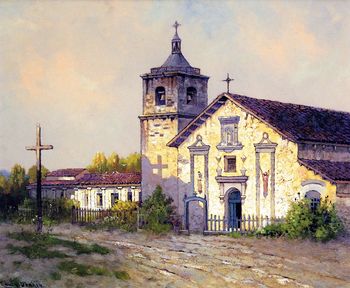Mission Santa Clara de Asís
 Mission Santa Clara de Asís, circa 1899.[1] Mission Santa Clara de Asís, circa 1899.[1]
| |
| HISTORY | |
|---|---|
| Location: | Santa Clara, California |
| Coordinates: | 37° 20′ 57.37″ N, 121° 56′ 29.76″ W |
| Name as Founded: | La Misión Santa Clara de Asís [2] |
| English Translation: | The Mission of Saint Clare of Assisi |
| Patron Saint: | Saint Clare of Assisi [3] |
| Founding Date: | January 12, 1777 [4] |
| Founded By: | Father Presidente Junípero Serra [5][6] |
| Founding Order: | Eighth [3] |
| Military District: | Fourth [7] |
| Native Tribe(s): Spanish Name(s): |
Bay Miwok, Tamyen, Yokuts Costeño |
| Primordial Place Name(s): | Socoisuka [8] |
| SPIRITUAL RESULTS | |
| Baptisms: | 8,536 [9] |
| Marriages: | 2,498 [9] |
| Burials: | 6,809 [9] |
| Neophyte Population | 1,125 [10] |
| DISPOSITION | |
| Secularized: | 1836 [3] |
| Returned to the Church: | 1858 [11] |
| Caretaker: | Roman Catholic Diocese of San Jose |
| Current Use: | Parish Church / University Chapel |
| National Historic Landmark: | #NPS-71000131 |
| Date added to the NRHP: | 1971 |
| California Historical Landmark: | #338 |
| Web Site: | http://www.scu.edu/mission/ |
Mission Santa Clara de Asís was founded on January 12, 1777 and named for Clare of Assisi, the founder of the order of the Order of Poor Ladies. Although ruined and rebuilt six times, the settlement was never abandoned.[12]
History
The first mission to be built to honor a woman, the outpost was originally established as La Misión Santa Clara de Thamien (or Mission Santa Clara de Thamien) at the Indian village of So-co-is-u-ka (meaning "Laurelwood," located on the Guadalupe River) on January 12, 1777. There they erected a cross and shelter for worship to bring Christianity to the Ohlone and Costanoan peoples. Floods and earthquakes damaged many of the early structures and forced relocation to higher ground. The second site is known as Mission Santa Clara de Asís. A subsequent site of the Mission dating from 1784 to 1819 is located several hundred yards west of the De La Cruz overpass of the CALTRAIN track; moreover, several Native American burial sites have been discovered near this subsequent site.[13] The current site, home to the first college in Alta California, dates back to 1828.[5]
Initially, there was tension between the people of the Mission and those in the nearby Pueblo de San Jose over disputed ownership rights of land and water. The tension was relieved when a road, The Alameda, was built by two hundred Indians to link the communities together. On Sundays, people from San Jose would come to the Mission for services, until the building of Cathedral Basilica of St. Joseph in 1803. In 1850, California became a state and priest of the Jesuit Order took over the Mission Santa Clara de Asís. Father John Nobili, S.J., was put in charge of the Mission. He began a college on the Mission site in 1851, which grew into Santa Clara University; it is the only mission to become part of a university, and it is also the oldest university in California. Throughout the history of the Mission, the bells have rung faithfully every evening, a promise made to King Charles III of Spain when he sent the original bells to the Mission in 1777. He asked that the bells be rung each evening at 8:30 in memory of those who had died.
Mission Santa Clara de Asís sits on the campus of the Santa Clara University. After a 1925 fire destroyed the 1828 mission structure, the church's parochial functions were transferred to St. Clare Parish Church, on Lexington Street west of the campus. A rebuilt and restored Mission Santa Clara was consecrated in 1929, when it assumed its primary modern function as chapel and centerpiece of the university campus. It is open to visitors every day; the Mission museum is located in the university's De Saisset Museum.
Other designations
- California Historical Landmark #250 — Old sites of Mission Santa Clara de Thamien and the Old Spanish Bridge
Notes
- ↑ (PD) Painting: Edwin Deakin
- ↑ Leffingwell, p. 137
- ↑ 3.0 3.1 3.2 Krell, p. 167
- ↑ Yenne, p. 80
- ↑ 5.0 5.1 Ruscin, p. 196. Cite error: Invalid
<ref>tag; name "ruscin196" defined multiple times with different content - ↑ Leffingwell, p. 137. Though Serra is generally credited with the Mission's founding, it was Father Tomás de la Peña who actually celebrated the first mass at the site.
- ↑ Forbes, p. 202
- ↑ Ruscin, p. 195
- ↑ 9.0 9.1 9.2 Krell, p. 315: as of December 31, 1832; information adapted from Engelhardt's Missions and Missionaries of California. Mission Santa Clara witnessed the greatest number of baptisms, marriages, and burials of any settlement in the Alta California chain.
- ↑ Krell, p. 315: as of December 31, 1832; information adapted from Engelhardt's Missions and Missionaries of California.
- ↑ Krell, p. 231
- ↑ Ruscin, p. 79
- ↑ Giglio, p. 3.11-1